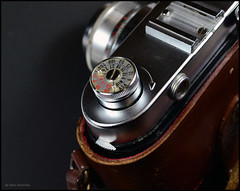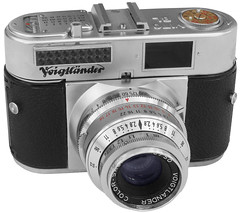Vito B

|
| The original Vito B image courtesy Lewis Collard (Image rights) |
The Vito B is an attractive and compact 35mm viewfinder introduced in 1954 by Voigtländer, and produced until 1959. The Vito B body existed in two versions. The first (1954 to 1957) had a small viewfinder and low profile top plate. The later version (1957 to 1959) had a larger bright-frame viewfinder.
Lenses
Both versions were fitted with the fine Color-Skopar 50mm fixed lens, with either an f/3.5 or f/2.8 maximum aperture (a four element Tessar-type) in a 4-speed Pronto or 9-speed Prontor shutter.
Shutter
Many Vito Bs were equipped with a 4-speed Pronto (B, 1/25th, 1/50th, 1/100th, and 1/200th sec., or B, 1/30th, 1/60th, 1/125th, 1/250th sec.), or 8-speed (B, 1, 1/2, 1/5th, 1/10th, 1/25th, 1/50th, 1/100th, and 1/300th sec.) Prontor SVS shutter.
There was also a 9-speed Prontor SVS (B, 1, 1/2, 1/4th, 1/8th, 1/15th, 1/30th, 1/60th, 1/125th, 1/300th sec.), plus one (rare) model with a nine speed Prontor SVS shutter that had the option of 1/500th (B, 1, 1/2, 1/5th, 1/10th, 1/25th, 1/50th, 1/100th, 1/300th, 1/500th sec.).
Later cameras had more modern 4 or 8 speed shutter steps within the range; B, 1, 1/2, 1/4, 1/8th, 1/15th. 1/30th, 1/60th, 1/125th, 1/300th, although some early large viewfinder Vito Bs had the older style shutter speed steps.
The last Vito Bs (both small and large viewfinder variants) also had the facility to set an Exposure Value, which synchronised shutter and aperture settings.
The shutter is cocked by the film engaging a sprocket wheel, preventing double exposure, and so will not cock if there is not a film present;[1] this has led some to mistakenly diagnose the shutter of a working Vito B as broken.
The self-timer mechanism can be engaged by moving the synchronising lever to the V (green) position; however, given the age of the camera and the weak governing spring,[2] using this feature is discouraged, as it can cause the camera to stop working.[1]
Nine times out of ten, a non working self timer is due to muck, not springs. There is a watch mechanism that controls the self timer, but, unlike a watch, it is not effectively sealed. Nearly all cameras with Prontor or Compur mechanisms need regular cleaning if they are used regularly. Even the shutter timing mechanism is clockwork and it only takes a speck of dust to jam it. People then start ripping them apart, usually from the wrong end and end up with a pile of non working bits. (Guess how I know). (Added by Laurie Pettitt)
Aesthetics and ergonomics

|
| Vito B large finder image by panaromico (Image rights) |

|
| Vito B popped-up rewind knob image by Hans Kerensky (Image rights) |
The Vito B's body is compact and rounded, a look characterised as "cute".[3] It has some nice features including a hinged baseplate for easy loading (which also releases the back), a milled film counter that counts down rather than up, and a switch-operated pop-up rewind knob.
While the later models had a brighter (and more useful than the original Vito B's) viewfinder, some enthusiasts feel that this spoiled the appearance of the camera.[4]
The counter to this assessment based on aesthetics is that the larger viewfinder made the camera easier to use.
Variants

|
| Vito BL image by Alf Sigaro (Image rights) |
There are some 11 variation of the Vito B, based upon 3 different types of shutter (including the rare 1/500th sec.) - offering 5 speed variations, two different lenses, with and without an EV setting lens scale, and small and large viewfinders.
Further variations were infact different cameras developed concurrently, and with a strong resemblance to the Vito B models.
a) The Voigtlander Vito BL featured an uncoupled selenium exposure meter.
b) The Vito BR had a coupled rangefinder and is quite uncommon.
Notes
Links
In English:
- Matt Denton, Voigtlander Vito B.
- Daniel Jiménez, Voigtländer Vito B
- Mike Elek (2008), Voigtlander Vito B.
- Keith South (2001), Voigtlander Vito B survey. Living Image Camera Museum.
- Keith South, Voigtlander Vito B, 35mm camera c1954.
- Small viewfinder Vito B, and Large viewfinder Vito B pages at My 35mm Film Camera Collection
In German:
- Hans Lißberger, Meine Voigtländer-Sammlung.
In French:
- Vito B, Vito BL, Vito B user manual: German and French on www.collection-appareils.fr by Sylvain Halgand